Guidance Notes for Developers
Protection of Existing Trees
Apart from the actual felling of trees on building sites, other less obvious factors can cause the loss of existing trees including: compaction of soil particularly by machinery; lowering of the water table due to new hard surfacing; drainage systems; the onset of disease following bad pruning or physical damage, and root damage sustained when utilities, road or foundations are laid. Death from these causes is often not immediate (in the case of semi or near mature trees they may die gradually over a number of years) and the loss of these can be avoided by discussion prior to planning application, change of layout and by adhering to the following Code of Practice. Reference can also be made to British Standard 5837 (1991) "Trees in Relation to Construction".
1. Trees to be shown on drawings
Developers are reminded that trees are existing features and should be shown on drawings. All trees over 100mm stem diameter should be shown with an accurate indication of canopy spread (to scale). Trees growing as shrubs together with large shrubs e.g. hawthorn, goat willow, need not be individually shown since a general indication will suffice.
2. Trees to be removed
Where a tree is to be removed it shall be clearly stated on drawings.
3. Trees to be retained
Trees to be retained shall be shown on drawings with approximate size, species if know and extent of canopy. Prior to starting on site it is essential that the site contractors are fully briefed on the actions needed to retain and protect trees, before the commencement of site works, including posting of a copy of the attached "Protection Notice".
4. Fencing of trees
Before the commencement of site works, trees which are to be retained must be protected by a 1.8m high fence as follows:-
- Around trees above 0.5m diameter, measured 1m above ground level, an enclosed area of not less than 40 square metres;
- Around trees below 0.5m diameter, measured 1m above ground level, an enclosed area of not less than 40 square metres;
- Around an area incorporating a group of trees or shrubs a fence along a line approximately under the outer perimeter of the branch spread, but not less than 2m from the stem in the case of shrubs. Fencing to be stout and solid, of a standard to withstand general knocks and storage piles.
5. Change of Ground Level
Changing the ground level around established trees should be avoided, but where inevitable specialist design advice should be sought before any work is undertaken.
6. Underground Services
Wherever possible all underground services should be located outside the normal root areas of any trees and placed in a common trench. Deep trenches and loss of large roots over 50mm diameter on one or both sides of a tree will affect its stability. To avoid root damage, excavations should not be within 6m if tree trunks or 3m of fastigiate (upright) trees.
Whenever possible, connection of essential site services to existing mains should be undertaken away from trees.
7. Site Hut Location
Site huts should be kept away from trees, but where this is not possible they should be raised on blocks, allowing air and water discharged from the roots to percolate the covered soil and sustain the underlying tree roots.
8. Heavy Plant Routes
Heavy plant should, wherever possible, be restricted to routes away from trees but where movement amongst trees is essential, obtrusive branches should be tied back before damage occurs and vulnerable trunks protected with fencing.
9. Siting of Mixers
Mixers should be sited away from trees and mixer spoil should be tipped on the sites of paths and paving areas etc., as the thick impermeable layer which accumulates beneath mixers deprives roots beneath them of essential water and air.
10. Storage of Soil
Excavated and replacement soil should not be piled against tree trunks as this may cause death of areas of bark by keeping them permanently moist.
11. Storage of Heavy Objects
Heavy objects should not be leant against trees as this may cause undue strain to be placed on the roots thereby affecting the stability of the trees at a later date.
12. Storage of Building Materials
Building materials should not be stacked against or near trees as this may bruise or crush areas of bark allowing decay to enter and their dead weight may destroy the soil structures by compaction. Materials should not be tipped near trees.
13. Bonfires
Any bonfires should be sited at least 3m from the branch tips of any tree and always on the leeward side of the tree as scorched leaves and branches may initiate insect or fungal attack and damage to the lower trunk may cause root death.
14. Treatment of Liquids
Liquids such as paint, oil, fuel, acids and cleaning fluids should not be allowed to spill near trees and their containers should not be discharged beneath trees as this may kill surface roots and cause fire risks or danger to children at a later date.
15. Stump Clearance
Those tree stumps which cannot be usefully incorporated in the landscape, say as features in a play area, should be grubbed out along with their major roots.
16. Weedkillers
Areas of ungraded weedy ground may look untidy and it may be necessary to remove weeds before handing the development over to the occupiers. The easiest and most effective way of doing this is by means of herbicides. Fortunately, several types of herbicide can be used which are unlikely to affect any trees present, but total weedkillers such as sodium chlorate, which are very mobile in the soil must be avoided as these may kill even large trees as well as the weeds.
17. Fences and Walls
At least 600mm should be left between new fences and walls and any trees to allow for basal swelling of the tree.
18. Trees in Paved Areas
Where trees are to be retained or planted within paved areas, adequate provision must be made for water to reach the feeder roots, i.e. an appropriate size surround of open soil or mulch.
Remember! If in doubt please discuss with the relevant Council Officers.


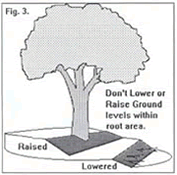
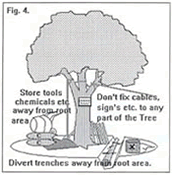
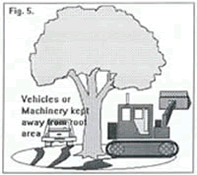
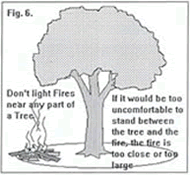
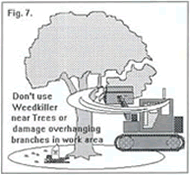
Contact information
Tameside MBC
PO Box 304
Ashton Under Lyne
Tameside
OL6 0GA

